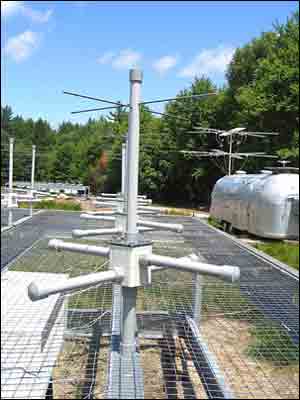Researchers find clue to start of universe

Photo / Alan Rogers, Haystack Observatory - Close-up view of the crossed dipole elements of the array used to detect deuterium at radio wavelengths at MIT’s Haystack Observatory in Westford
If you want to hear a little bit of the Big Bang, you’re going to have to turn down your stereo.
That’s what neighbors of MIT’s Haystack Observatory found out. They were asked to make a little accommodation for science, and now the results are in: Scientists at Haystack have made the first radio detection of deuterium, an atom that is key to understanding the beginning of the universe. The findings are being reported in an article in the Sept. 1 issue of Astrophysical Journal Letters.
The team of scientists and engineers, led by Alan E.E. Rogers, made the detection using a radio telescope array designed and built at the MIT research facility in Westford, Mass. Rogers is currently a senior research scientist and associate director of the Haystack Observatory.
After gathering data for almost one year, a solid detection was obtained on May 30.
The detection of deuterium is of interest because the amount of deuterium can be related to the amount of dark matter in the universe, but accurate measurements have been elusive. Because of the way deuterium was created in the Big Bang, an accurate measurement of deuterium would allow scientists to set constraints on models of the Big Bang.
Also, an accurate measurement of deuterium would be an indicator of the density of cosmic baryons, and that density of baryons would indicate whether ordinary matter is dark and found in regions such as black holes, gas clouds or brown dwarfs, or is luminous and can be found in stars. This information helps scientists who are trying to understand the very beginning of our universe.
Until now the deuterium atom has been extremely difficult to detect with instruments on Earth. Emission from the deuterium atom is weak since it is not very abundant in space-there is approximately one deuterium atom for every 100,000 hydrogen atoms, thus the distribution of the deuterium atom is diffuse. Also, at optical wavelengths the hydrogen line is very close to the deuterium line, which makes it subject to confusion with hydrogen; but at radio wavelengths, deuterium is well separated from hydrogen and measurements can provide more consistent results.
In addition, our modern lifestyle, filled with gadgets that use radio waves, presented quite a challenge to the team trying to detect the weak deuterium radio signal. Radio frequency interference bombarded the site from cell phones, power lines, pagers, fluorescent lights, TV, and in one case from a telephone equipment cabinet where the doors had been left off. To locate the interference, a circle of yagi antennas was used to indicate the direction of spurious signals, and a systematic search for the RFI sources began.
At times, Rogers asked for help from Haystack’s neighbors, and in several instances replaced a certain brand of answering machine that was sending out a radio signal with one that did not interfere with the experiment. The interference caused by one person’s stereo system was solved by having a part on the sound card replaced by the factory.
The other members of the team working with Rogers are Kevin Dudevoir, Joe Carter, Brian Fanous and Eric Kratzenberg (all of Haystack Observatory) and Tom Bania of Boston University.
The Deuterium Array at Haystack is a soccer-field size installation conceived and built at the Haystack facility with support from the National Science Foundation, MIT and TruePosition Inc.
Media Contact
All latest news from the category: Physics and Astronomy
This area deals with the fundamental laws and building blocks of nature and how they interact, the properties and the behavior of matter, and research into space and time and their structures.
innovations-report provides in-depth reports and articles on subjects such as astrophysics, laser technologies, nuclear, quantum, particle and solid-state physics, nanotechnologies, planetary research and findings (Mars, Venus) and developments related to the Hubble Telescope.
Newest articles

“Nanostitches” enable lighter and tougher composite materials
In research that may lead to next-generation airplanes and spacecraft, MIT engineers used carbon nanotubes to prevent cracking in multilayered composites. To save on fuel and reduce aircraft emissions, engineers…

Trash to treasure
Researchers turn metal waste into catalyst for hydrogen. Scientists have found a way to transform metal waste into a highly efficient catalyst to make hydrogen from water, a discovery that…

Real-time detection of infectious disease viruses
… by searching for molecular fingerprinting. A research team consisting of Professor Kyoung-Duck Park and Taeyoung Moon and Huitae Joo, PhD candidates, from the Department of Physics at Pohang University…





















